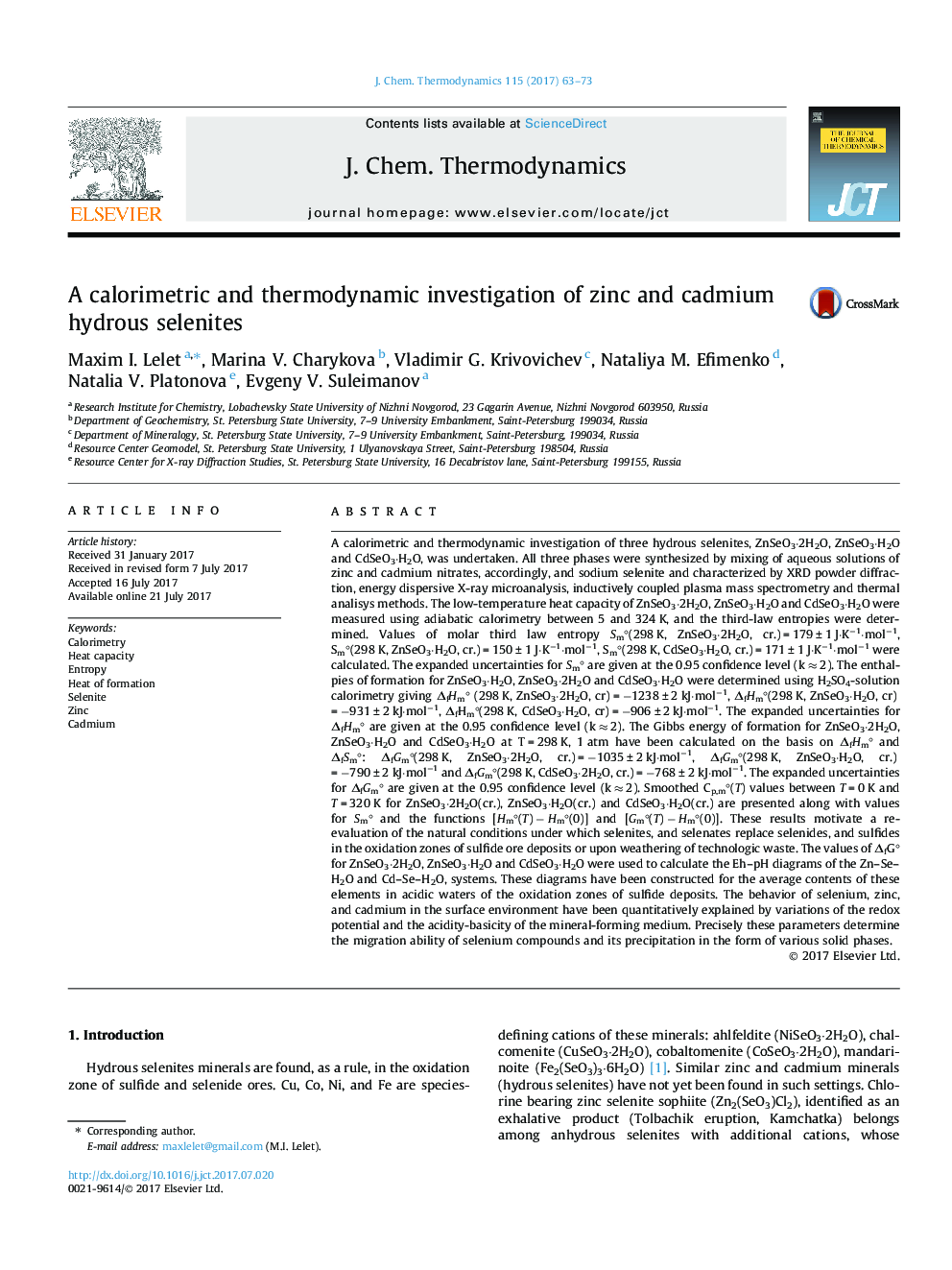| کد مقاله | کد نشریه | سال انتشار | مقاله انگلیسی | نسخه تمام متن |
|---|---|---|---|---|
| 4907280 | 1426198 | 2017 | 11 صفحه PDF | دانلود رایگان |
عنوان انگلیسی مقاله ISI
A calorimetric and thermodynamic investigation of zinc and cadmium hydrous selenites
ترجمه فارسی عنوان
بررسی کالریمتریک و ترمودینامیکی سلنیت هیدروژن روی و کادمیم
دانلود مقاله + سفارش ترجمه
دانلود مقاله ISI انگلیسی
رایگان برای ایرانیان
کلمات کلیدی
کالریمتری، ظرفیت گرمایی، آنتروپی، گرمای تشکیل سلنیت، فلز روی، کادمیوم،
موضوعات مرتبط
مهندسی و علوم پایه
مهندسی شیمی
مهندسی شیمی (عمومی)
چکیده انگلیسی
A calorimetric and thermodynamic investigation of three hydrous selenites, ZnSeO3·2H2O, ZnSeO3·H2O and CdSeO3·H2O, was undertaken. All three phases were synthesized by mixing of aqueous solutions of zinc and cadmium nitrates, accordingly, and sodium selenite and characterized by XRD powder diffraction, energy dispersive X-ray microanalysis, inductively coupled plasma mass spectrometry and thermal analisys methods. The low-temperature heat capacity of ZnSeO3·2H2O, ZnSeO3·H2O and CdSeO3·H2O were measured using adiabatic calorimetry between 5 and 324 K, and the third-law entropies were determined. Values of molar third law entropy Sm°(298 K, ZnSeO3·2H2O, cr.) = 179 ± 1 J·Kâ1·molâ1, Sm°(298 K, ZnSeO3·H2O, cr.) = 150 ± 1 J·Kâ1·molâ1, Sm°(298 K, CdSeO3·H2O, cr.) = 171 ± 1 J·Kâ1·molâ1 were calculated. The expanded uncertainties for Sm° are given at the 0.95 confidence level (k â 2). The enthalpies of formation for ZnSeO3·H2O, ZnSeO3·2H2O and CdSeO3·H2O were determined using H2SO4-solution calorimetry giving ÎfHm° (298 K, ZnSeO3·2H2O, cr) = â1238 ± 2 kJ·molâ1, ÎfHm°(298 K, ZnSeO3·H2O, cr) = â931 ± 2 kJ·molâ1, ÎfHm°(298 K, CdSeO3·H2O, cr) = â906 ± 2 kJ·molâ1. The expanded uncertainties for ÎfHm° are given at the 0.95 confidence level (k â 2). The Gibbs energy of formation for ZnSeO3·2H2O, ZnSeO3·H2O and CdSeO3·H2O at T = 298 K, 1 atm have been calculated on the basis on ÎfHm° and ÎfSm°: ÎfGm°(298 K, ZnSeO3·2H2O, cr.) = â1035 ± 2 kJ·molâ1, ÎfGm°(298 K, ZnSeO3·H2O, cr.) = â790 ± 2 kJ·molâ1 and ÎfGm°(298 K, CdSeO3·2H2O, cr.) = â768 ± 2 kJ·molâ1. The expanded uncertainties for ÎfGm° are given at the 0.95 confidence level (k â 2). Smoothed Cp,m°(T) values between T = 0 K and T = 320 K for ZnSeO3·2H2O(cr.), ZnSeO3·H2O(cr.) and CdSeO3·H2O(cr.) are presented along with values for Sm° and the functions [Hm°(T) â Hm°(0)] and [Gm°(T) â Hm°(0)]. These results motivate a re-evaluation of the natural conditions under which selenites, and selenates replace selenides, and sulfides in the oxidation zones of sulfide ore deposits or upon weathering of technologic waste. The values of ÎfG° for ZnSeO3·2H2O, ZnSeO3·H2O and CdSeO3·H2O were used to calculate the Eh-pH diagrams of the Zn-Se-H2O and Cd-Se-H2O, systems. These diagrams have been constructed for the average contents of these elements in acidic waters of the oxidation zones of sulfide deposits. The behavior of selenium, zinc, and cadmium in the surface environment have been quantitatively explained by variations of the redox potential and the acidity-basicity of the mineral-forming medium. Precisely these parameters determine the migration ability of selenium compounds and its precipitation in the form of various solid phases.
ناشر
Database: Elsevier - ScienceDirect (ساینس دایرکت)
Journal: The Journal of Chemical Thermodynamics - Volume 115, December 2017, Pages 63-73
Journal: The Journal of Chemical Thermodynamics - Volume 115, December 2017, Pages 63-73
نویسندگان
Maxim I. Lelet, Marina V. Charykova, Vladimir G. Krivovichev, Nataliya M. Efimenko, Natalia V. Platonova, Evgeny V. Suleimanov,
